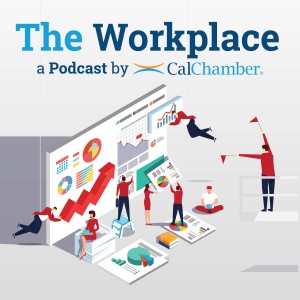In this episode of The Workplace podcast, CalChamber Executive Vice President and General Counsel Erika Frank and CalChamber policy advocate Robert Moutrie discuss California’s new COVID-19 workplace exposure reporting law, which goes into effect on January 1, 2021.
In September, Governor Gavin Newsom signed AB 685 (Reyes; D-San Bernardino), which among other requirements, mandates that employers give employees and public health agencies notice of COVID-19 exposures that happen at the workplace, starting January 1, 2021.
Moutrie cautions that the requirements set forth in the new law can be onerous and recommends that employers consult with their legal counsel as soon as they can to ensure that their company is in compliance with the new law come January 1.
Employee Notice
AB 685 requires three types of information be sent to employees — notice of exposure, information about leave policies and information regarding “disinfection and safety plans.” Additionally, the three notice types required will need to be provided to three different groups of employees. Employers will need to determine who will be required to get a notice, what type of notice those employees will get and how the notice will be delivered to those employees within a business day, Moutrie explains.
The law requires that the following groups of employees receive notice of COVID-19 exposure in the workplace within one business day of when the employer received notice of potential exposure:
- Employees who were at the worksite where a potentially sick employee or member of the public was;
- Any employee who may have been exposed;
- All employees in charge of cleanup procedures.
Moutrie points out that some definitions, such as the second category, which states that “any employee who may have been exposed,” are overly broad and he is hopeful that clarification will be given in the coming months via “cleanup” legislation.
Notice must be given in writing and not just given orally. The written notice may be given in the way that the employer normally communicates with its employees, Moutrie says. For example, if an employer normally communicates with its employees via email, an email detailing the exposure may be sent out, accompanied with attachments to the company’s leave policies.
Moutrie stresses that the timeline to send out these notices is tight — just one business day. So, it is important that employers identify the affected population groups quickly, preferably with the aid of legal counsel.
Notice to Public Agencies
Employers also will be required to provide local public health agencies notice of a workplace “outbreak,” which is currently defined as three workplace exposures within a two-week period, Moutrie tells listeners.
Another problematic aspect of AB 685 is that it relies on the definitions given by the U.S. Centers for Disease Control and Prevention (CDC) and California Department of Public Health (CDPH), which may change at any time. For example, he says, the CDC may change what constitutes a positive test, and that will affect the requirements set forth in AB 685.
Employers and legal counsel will need to keep an eye out for definition changes to ensure compliance, Moutrie stresses.
Using the notice that employers give to the CDPH, California will be publishing COVID-19 outbreak data, but it is not yet clear how the state will do so, Moutrie says. The state may choose to reveal outbreaks by address or it may aggregate the data and reveal outbreaks regionally.
Unclear Language
AB 685 contains unclear language that Moutrie says will hopefully be cleared up in upcoming “cleanup” legislation. As mentioned previously, some definitions are vague and inconsistent.
For example, the present text requires employers to provide certain notice to all employees who “may have been exposed,” which is not defined. Also, while AB 685 requires that employers provide employees with the CDC’s “disinfection and safety plan,” the CDC does not have a “disinfection and safety” plan. The agency does, however, have a “cleaning and disinfecting” plan, related to cleaning areas that have been exposed.
This is one of the reasons employers should consult with legal counsel, Moutrie points out.
“Issues like that are going to make things really hard for a small businessperson on their own to just figure out what to do,” he says.
Exemptions
AB 685 exempts medical facilities that are specifically treating individuals with COVID-19 from reporting exposures to public health agencies. So, for example, a chiropractic office would not qualify for the exemption, but a hospital would be exempted.
The exemption applies to the patients at the facility — if a staff member becomes infected, then the employer falls out of the exemption and will need to abide by the reporting requirements, Moutrie explains.
Next Steps
In order to prepare for these new requirements, Moutrie recommends that employers reach out to legal counsel, and begin setting up a mechanism of notification to ensure that notices can be sent out within one business day. Employers can begin setting up mailing lists and write up notice templates ahead of time. Now is also a good time to designate someone in the company to be in charge of sending out these notices, he says.



